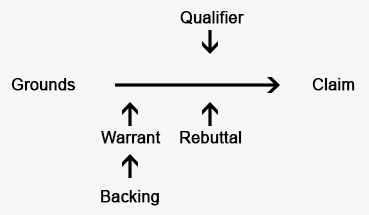The Toulmin model of argumentation
The English philosopher Stephen Toulmin has identified the elements of a persuasive argument. These elements are useful tools in an analysis of an argumentative text.
Toulmin distinguishes between a basic and an extended model.
The basic model
Claim: The point of view or statement which you are asking another person to accept as
true.
Grounds: The facts or reasoning that should persuade the other person to accept the claim.
Warrant: The logical connection between the claim and the grounds. The warrant is
a general truth, which it is assumed that the sender and receiver share. It is often
implicit.

The extended model
Backing: Additional support for the argument, e.g. a reference to precedents or statistics.
Qualifier: Words or expressions that indicate how strong the argument is in the eyes of the
sender.
Rebuttal: A preemption of a counter-argument. The sender anticipates a
counter-argument, thereby weakening it.

An example:
Muhammadu Buhari probably won the democratic presidential election in 2015 because he was seen as the best candidate to fight Boko Haram and corruption even though he is a former military general and dictator. Furthermore, Buhari is reknown for his personal incorruptability and simple lifestyle.
Claim: Muhammadu Buhari won the democratic presidential election in 2015
Ground: because he was seen as the best candidate to fight Boko Haram and corruption
Warrant: (implicitly: Boko Haram and corruption were the main issues of the election)
Backing: Furthermore, Buhari is reknown for his personal incorruptibility and simple
lifestyle
Qualifier: probably
Rebuttal: even though he is a former military general and dictator
